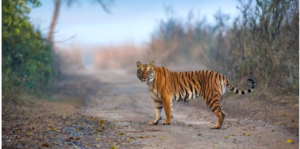Elusive Tiger Captured in Kannur After Two-Week: After a relentless two-week search operation, wildlife authorities in Kannur, Kerala, have successfully captured an elusive tiger that had been roaming the area, sparking fear and concern among residents. The capture of the tiger marks the culmination of a coordinated effort involving wildlife officials, forest department personnel, local authorities, and expert trackers. This article aims to provide a detailed account of the events leading up to the tiger’s capture, highlighting the challenges faced during the operation, and examining the implications for wildlife conservation and human-wildlife conflict mitigation efforts.

The saga began when reports surfaced of a tiger sighting in the forests of Kannur district, sending shockwaves through the local community. The presence of the big cat in close proximity to human settlements raised fears of potential conflicts and posed a threat to both human safety and the tiger’s well-being. Wildlife authorities immediately launched a search operation to locate and safely capture the tiger, deploying a combination of ground patrols, camera traps, and drone surveillance to track its movements.
The dense forests and rugged terrain of Kannur presented formidable challenges to the search operation, hampering efforts to locate the elusive tiger. Moreover, the elusive nature of the big cat, coupled with its ability to cover vast distances, made it a daunting task for wildlife officials to predict its whereabouts accurately. Concerns were also raised about the safety of local residents and livestock, prompting authorities to issue advisories and precautionary measures to minimize the risk of encounters with the tiger.
As the search operation intensified, wildlife authorities sought to enlist the support of local communities in their efforts to locate the tiger. Public awareness campaigns were conducted to educate residents about the importance of coexisting with wildlife and adopting precautionary measures to avoid confrontations with the tiger. Additionally, community volunteers and trained trackers were mobilized to assist wildlife officials in scouring the forests and gathering intelligence on the tiger’s movements.
To augment their search efforts, wildlife authorities leveraged the latest technology, including camera traps and drones, to monitor the tiger’s movements and gather vital intelligence. Camera traps strategically placed in key locations captured images of the elusive big cat, providing valuable insights into its behavior and habitat preferences. Similarly, drones equipped with thermal imaging cameras were deployed to conduct aerial surveys and track the tiger’s movements during the night.
After days of relentless pursuit, wildlife authorities finally succeeded in locating the tiger’s whereabouts and devised a plan to safely capture the elusive feline. Expert trackers, armed with tranquilizer darts, approached the tiger cautiously, ensuring minimal disturbance to its natural habitat. With precision and skill, the tranquilizer dart was administered, temporarily immobilizing the tiger and allowing wildlife officials to safely transport it to a designated rescue center for medical evaluation and rehabilitation.
The successful capture of the elusive tiger in Kannur underscores the importance of proactive conservation efforts and collaborative approaches to mitigating human-wildlife conflicts. By employing a combination of community engagement, technological innovation, and expert tracking, wildlife authorities demonstrated their commitment to ensuring the safety of both wildlife and local communities.
Moving forward, it is imperative for authorities to implement comprehensive strategies for managing human-wildlife interactions and promoting habitat conservation. This includes the development of early warning systems, the establishment of wildlife corridors, and the implementation of community-based conservation initiatives aimed at fostering harmonious coexistence between humans and wildlife.
The capture of the elusive tiger in Kannur represents a significant milestone in wildlife conservation efforts in Kerala. It serves as a testament to the dedication and expertise of wildlife authorities and underscores the importance of proactive measures in mitigating human-wildlife conflicts. As we celebrate this achievement, it is essential to remain vigilant and proactive in our efforts to protect and conserve India’s rich biodiversity for future generations.





